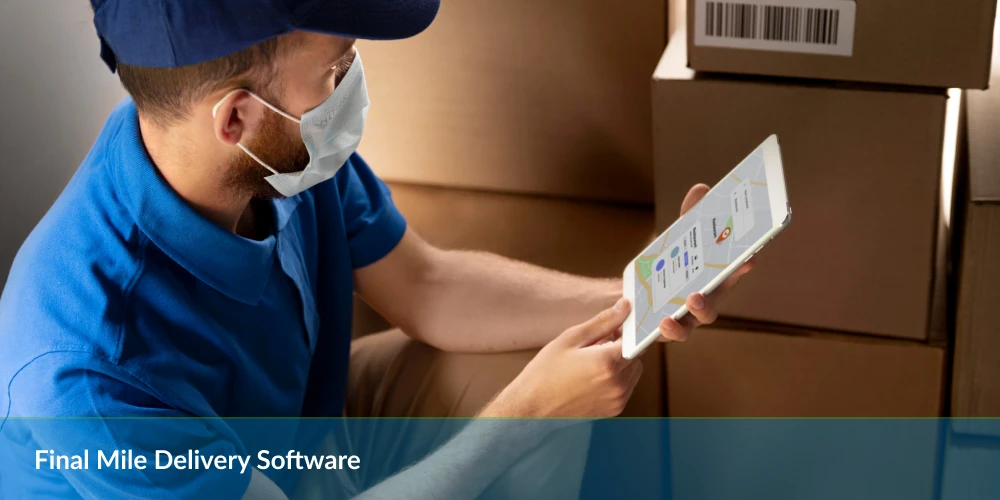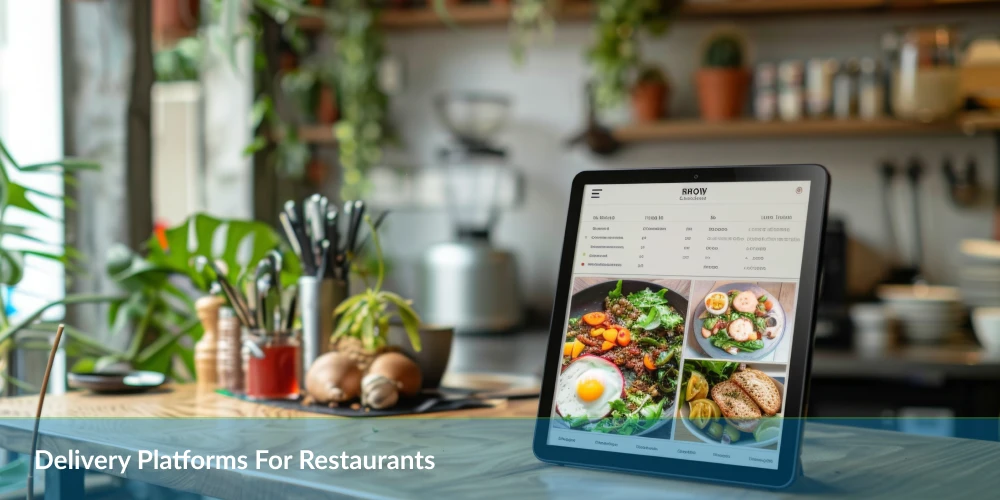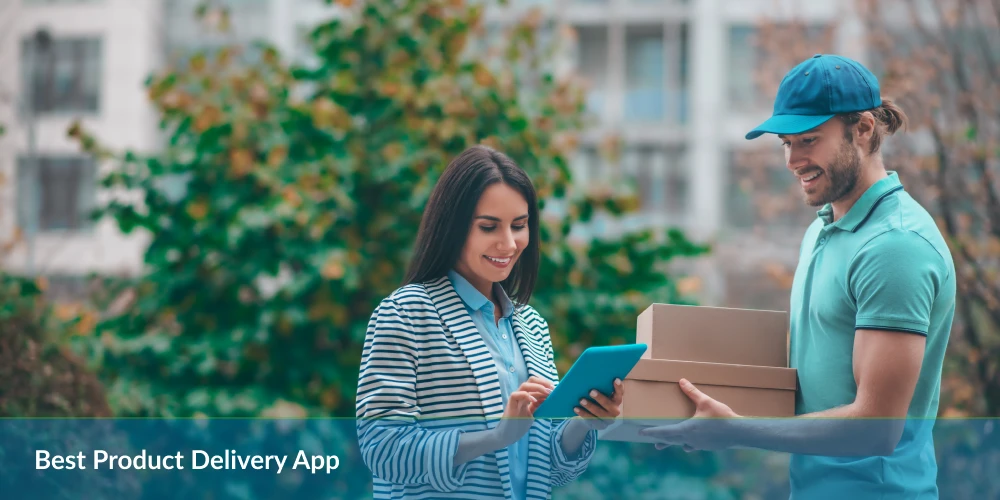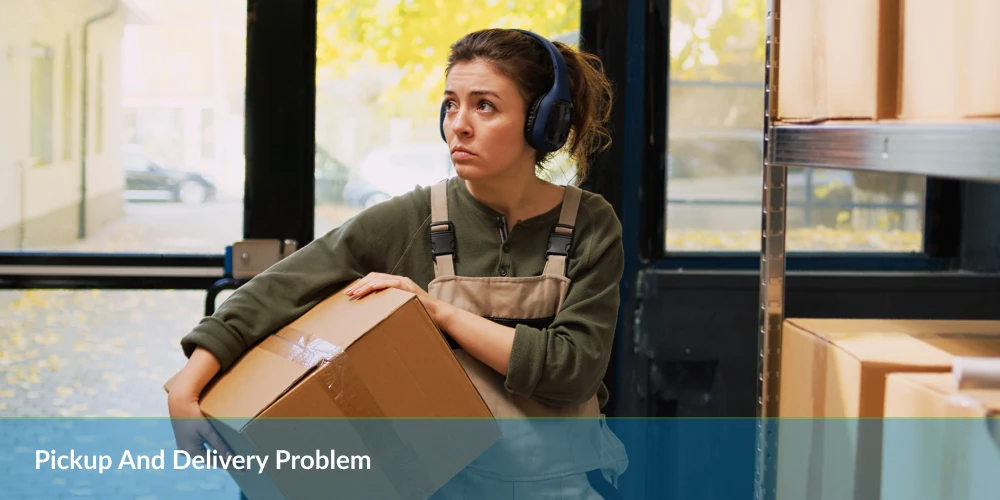Table of Contents
Final mile delivery, also known as last-mile delivery, refers to the final stage in the e-commerce logistics chain, where a purchased item moves from a distribution hub to the customer’s doorstep. While this leg may be the shortest in terms of distance, final-mile delivery solutions carry disproportionate weight in shaping the customer experience.
“55% of consumers are willing to pay for same-day delivery, 45% for next-day delivery, and 68% actively seek shorter delivery windows during checkout.”
Source: Meteor Space
Final mile performance directly impacts brand perception. On-time arrivals, courteous drivers, and hassle-free drop-offs translate into repeat sales and lower churn. Missed windows and vague status updates have the opposite effect. Customers don’t separate the carrier from the retailer; they associate the final mile with the brand itself. That moment of delivery either builds loyalty or breaks it.
Breaking Down Final Mile Delivery: What Makes It Work in E-commerce
Errors in the final mile compound quickly. A single incorrect address entry or failure to note a customer’s delivery preference results in failed deliveries, costly redelivery attempts, and negative customer reviews. For e-commerce businesses, efficient shipment handling at this stage is crucial for achieving high delivery success rates and fostering repeat customer transactions.
Barcode scanning, address validation systems, and real-time data syncing with customer orders reduce such risks drastically. When shipments are tightly integrated with fulfillment data, drivers know exactly what to deliver, when to arrive, and how to navigate destination-specific delivery parameters.
The Last Mile Carries the Heaviest Operational Load
Across the full logistics chain, the last mile represents both the most operationally complex and financially demanding segment. According to a 2023 report from Capgemini Research Institute, last-mile delivery costs can account for up to 53% of total shipping expenses. This cost spike emerges from fragmented delivery endpoints, diverse customer demands, unpredictability, and underutilized vehicle capacity.
In urban areas, congestion and failed first-attempt deliveries push costs higher. In rural zones, long distances between stops limit order density and increase fuel consumption per delivery. Unlike line-haul transportation or centralized warehouse operations, last-mile delivery lacks performance economies of scale—each trip must be optimized uniquely.
Stakeholders Shape the Dynamic
Coordination doesn’t happen by accident. Several key players align to make the final mile delivery function:
| Stakeholder | Role in Delivery Experience |
| Retailers | Define delivery speed and cost expectations through promises made at checkout. |
| 3PLs & Carriers | Plan, fulfill, and execute delivery strategies using their fleets and logistics systems. |
| Drivers (W2 or Gig Workers) | Serve as the brand’s human interface; their punctuality and professionalism directly impact customer retention. |
| Customers | Generate demand and shape performance standards, influenced by top brands offering fast, trackable deliveries. |
Striking alignment among these stakeholders requires integrated platforms, data transparency, and feedback loops that feed directly into operational adjustments. One late package or one delivery incident slips quickly into public reviews, pushing businesses to invest further in visibility and accountability mechanisms.
Delivery Route Optimization: Reducing Time and Cost
Algorithms now outperform human intuition in planning final-mile delivery routes. Machine learning systems analyze traffic conditions, weather data, delivery windows, and historical trends to make real-time adjustments. These systems prioritize stops, continuously recalibrate ETAs, and reroute drivers on the fly. Resources like NetworkON, Route4Me, Verizon Connect, and Onfleet integrate AI to deliver optimal sequence routing that adapts hour by hour.
Companies implementing AI-based route planning report measurable improvements. For example, UPS’s ORION platform, which processes over 1 billion data points daily, reduced driving by 100 million miles annually across its fleet. That represents more than 10 million gallons of fuel saved each year, paired with a reduction of 100,000 metric tons in CO2 emissions.
Fuel Efficiency and Driver Productivity
Fewer miles driven lead directly to lower fuel expenses. According to the American Transportation Research Institute (ATRI), fuel accounts for 24% to 38% of overall motor carrier operating costs. Reducing even a fraction of these miles yields significant financial results. Additionally, smart routing eliminates idle time, minimizes traffic exposures, and increases the number of daily deliveries a driver can complete.
Operational productivity gains compound quickly. A driver completing 20 stops per day can increase to 25 with better routing, a 25% boost in output without additional labor cost. This not only cuts down on per-package delivery costs but also improves customer satisfaction through tighter delivery windows.
In 2024, about 76% of retail executives marked reducing the total cost per order as their leading priority in last-mile delivery. This highlights a growing focus on balancing speed with cost-efficiency in fulfilling customer expectations.
Source: CNBC
Optimization tools do more than just map a route. They predict delays, offer alternatives instantly, and scale across hundreds of daily runs with precision that manual planning cannot match. Efficiency on the road no longer depends on experience; it now depends on data.
Real-Time Order Tracking: Enhancing Customer Experience and Trust
Online shoppers no longer consider real-time tracking a luxury; it’s the baseline expectation. From the second they click ‘purchase’, they want to know: when will it ship, where is it now, and what time will it arrive? This demand stems from a shift in purchase motivation. Convenience has now overtaken price as a key purchase driver, especially during the final mile stage. According to a survey by Convey, 84% of consumers say they won’t return after just one poor delivery experience, and 98% want full visibility into their orders.
GPS and API Integration Deliver on Transparency
Modern final-mile delivery solutions now integrate GPS tracking systems and real-time APIs to meet this requirement. These integrations offer up-to-the-minute location data and ETAs, pulling directly from telematics solutions in delivery vehicles or devices carried by delivery personnel. By embedding these capabilities into white-label branded tracking pages, companies retain control over the customer experience and brand perception.
| Technology | Functionality |
| GPS Devices | Feed continuous data to dashboards, enabling route deviation alerts and live location sharing. |
| Tracking APIs | Connect logistics providers with e-commerce platforms, enabling native order tracking without app switching. |
| Geofencing Triggers | Send notifications when drivers enter or exit predefined zones, improving the accuracy of doorstep delivery timing. |
Reducing Failed Delivery Attempts
Real-time tracking doesn’t only serve the end customer. It significantly improves delivery success rates. When recipients know precisely when a package will arrive, the odds of someone being present at the delivery address increase. Fewer missed deliveries mean fewer costly re-attempts, lower storage costs, and fewer customer service complaints.
Amazon’s in-app map tracking feature provides a prime example. It shows shoppers the exact number of stops away their driver is, which contributes to an average 7% reduction in failed deliveries. That kind of precision and accountability scales across fleets when implemented via route management software integrated with real-time telemetry.
Bolstering Customer Satisfaction and Brand Loyalty
Customers link transparent communication with trustworthy service. Giving them access to real-time tracking builds confidence and reduces friction, especially for high-value or time-sensitive shipments. It transforms passive anticipation into an active delivery experience, a competitive differentiator that strengthens repeat business and drives up net promoter scores (NPS).
Every order update, from departure scan to final doorstep drop-off, reinforces a brand’s reliability. In a saturated e-commerce market, meeting the demand for visibility isn’t just operationally smart. It directly affects customer retention, loyalty, and, ultimately, revenue growth.
Pro Tip: Embed branded real-time tracking directly into your post-purchase flow to boost trust, reduce delivery failures, and turn one-time buyers into loyal customers.
Redefining Customer Satisfaction in Final Mile Delivery
Generic delivery schedules and impersonal updates no longer meet expectations. Consumers demand precision and control. Modern final-mile delivery solutions now offer personalized time windows based on real-time traffic data, customer availability, and geographic intelligence. This tailoring is more than a convenience; it’s a differentiator.
Customers respond positively to messaging tailored to their preferences. Whether through SMS, email, or app notification, brands that allow users to choose how and when they receive updates increase engagement and reduce failed delivery attempts. This level of personalization transforms what was once a passive waiting period into an interactive part of the customer journey.
Real-Time Transparency and Seamless Returns
Clarity in delivery timelines builds trust. A 2023 report from Metapack reveals that 70% of online shoppers say real-time tracking updates directly influence their satisfaction. Providing live status updates, ETAs refreshed in real-time, and photographs of delivered packages eliminate ambiguity and significantly reduce inbound customer service queries.
On the flip side, return experiences remain a litmus test for long-term customer retention. Companies that streamline this process, offering prepaid return labels, pick-up at home options, and frictionless refund timelines, see stronger customer loyalty metrics. According to Narvar, 96% of customers who rate their return experience as “easy” say they would shop with the retailer again.
Same-Day and Next-Day Delivery Options: Meeting Customer Expectations
To activate same-day and next-day delivery services at scale, businesses must build or access a dense and flexible logistics network. This includes distributed fulfillment centers located close to high-demand zones, urban micro-warehouses, dark stores repurposed for rapid order picking, and strategically positioned cross-dock facilities. Without these physical assets, cutting delivery windows to under 24 hours becomes operationally unfeasible in most regions.
Amazon, for example, operates over 110 active fulfillment centers in the U.S. alone. This proximity to consumers allows the company to offer same-day delivery to over 90 metropolitan areas. Walmart relies on more than 4,700 retail locations, each acting as a potential last-mile node, to fulfill online orders within hours. Infrastructure depth equals time compression.
Speed vs. Feasibility: The Trade-Off Equation
Compressed timeframes in delivery require trade-offs. Businesses must calculate the economic viability of fast shipping against fulfillment complexity, process automation, and driver availability. A McKinsey study found that offering same-day delivery increases fulfillment costs by 1.5 to 2 times compared to standard delivery. The faster the expected delivery, the narrower the window for order batching, route consolidation, and resource optimization.
- Same-day delivery demands real-time order processing. Orders must be picked, packed, and out the door within minutes of confirmation.
- Next-day delivery allows slightly more flexibility, but still places intense pressure on late-night fulfillment and early-morning dispatch cycles.
- Carrier coordination becomes more complex due to lower route density and tighter drop-off timeframes.
Every delivery network must find its balance between efficiency and speed, anchored in the density of demand, margin constraints, and service promise thresholds.
Smart Integration with E-commerce Platforms
Pairing final-mile delivery systems with e-commerce platforms produces immediate operational advantages. Syncing systems eliminates data silos, streamlines order processing, and gives businesses full visibility into fulfillment timelines. Customers receive accurate delivery windows as early as the shopping cart stage, and backend teams gain greater control over scheduling and carrier coordination.
Retailers using integrated solutions see measurable improvements. This integration doesn’t just reduce fulfillment time; it also reduces customer support tickets tied to order updates.
APIs and Plug-ins for Real-Time Delivery Updates at Checkout
Modern e-commerce platforms like Shopify, Magento, and BigCommerce support delivery API plug-ins that transmit live delivery estimates straight to the customer during checkout. These APIs pull real-time data from carrier systems—such as DHL, FedEx, or specialized final mile providers—to show tailored windows based on serviceable zones, current vehicle locations, and traffic patterns.
- Shopify: Supports integrations like Shippo, EasyPost, and Bringg for real-time rates and tracking info directly in the cart and order confirmation sections.
- Magento: Offers extensible APIs compatible with last-mile logistics platforms like Onfleet or FarEye.
- WooCommerce: Uses RESTful APIs and plug-ins like Route and AfterShip to push end-to-end visibility to both customers and fulfillment teams.
When these APIs work in tandem with predictive analytics, checkout delivery dates become not just an estimate, but a dynamic commitment calculated using live data.
Seamless Backend Integration Improves Logistics Efficiency
Deep integration across the tech stack, ERP, WMS, and delivery management software removes bottlenecks throughout the fulfillment journey. When an order is placed, integrated platforms trigger automated assignments to available delivery fleets, generate optimized routes, and initiate drop-off confirmations via mobile apps for drivers. This orchestrated sequence minimizes human input and compresses delivery cycles.
For instance, integrating a route optimization engine with an order management system allows dispatchers to automatically group deliveries by region and time slot immediately after purchase. No more manual sorting or back-and-forth between spreadsheets and mapping software.
In logistics, milliseconds matter. Fully integrated backend systems let companies respond faster to order spikes, reroute deliveries on the fly, and onboard new carriers with minimal downtime, all without touching the underlying e-commerce codebase. That freedom allows teams to focus on scale, not system maintenance.
Going Green: Environmental Sustainability in Last Mile Logistics
Alternative delivery modes are redefining the environmental impact of final-mile logistics. Electric vehicles (EVs), once limited by cost and range constraints, now offer a scalable path toward lower emissions. The global electric van market was valued at USD 13,328.8 million in 2023 and is expected to grow to USD 32,016.2 million by 2030, registering a CAGR of 13.3% between 2024 and 2030, according to Grand View Research.
Carbon-neutral delivery options, such as Shopify’s Planet initiative and UPS’s carbon offset programs, allow merchants to counterbalance emissions by investing in reforestation and regenerative agriculture projects. These services aren’t just checkboxes; they’re measurable actions tied directly to carbon accounting protocols and verifiable third-party audits.
Sustainability and Brand Perception
Consumer awareness is applying pressure: Last-mile sustainability isn’t an isolated initiative; it influences conversion rates, brand retention, and net promoter scores. Brands integrating clear, measurable sustainability efforts into the final mile, such as disclosing CO2 savings per order or using recyclable packaging, build credibility. This kind of transparency transforms ecological practices into tangible marketing assets.
Pro Tip: Integrate electric vehicles and carbon-neutral delivery options into your last-mile strategy to boost sustainability and brand trust.
Key Takeaways:
- Customer Experience Drives Loyalty: Final-mile delivery shapes brand perception; on-time professional service encourages repeat purchases, while delays or poor interactions increase churn.
- Cost Efficiency is a Top Priority: In 2024, 76% of retail executives focused on reducing the total cost per order, highlighting the need to balance speed with sustainable delivery economics.
- Smart Routing Improves Productivity: AI-powered route optimization tools like UPS’s ORION help reduce mileage, fuel usage, and delivery time, boosting both operational efficiency and environmental sustainability.
- Real-Time Tracking Enhances Trust: Live GPS tracking and API integrations provide transparency, reduce failed delivery attempts, and improve customer satisfaction with accurate ETAs.
- Sustainability Matters to Consumers: Electric vehicles and carbon-neutral options are becoming key brand differentiators, with the global electric van market expected to more than double by 2030.
Wrapping It Up!
Logistics, customer service, and technology don’t operate in silos, they form a single, interdependent system. Aligning these elements within your final-mile delivery strategy transforms fulfillment from a cost center into a competitive advantage. Every handoff, every scan, and every doorstep delivery feed into a broader experience your customers remember.
Integrated final-mile delivery solutions create multiple wins. Start with data-driven route planning to reduce last-mile delivery costs. Then embed real-time visibility with GPS-based tracking and API-connected platforms to eliminate uncertainty. Add responsive customer service that matches delivery performance with direct communication. The result? Seamless experiences that customers reward with loyalty and repeat purchases.
Companies that prioritize final mile precision don’t just deliver packages, they deliver expectations met, promises kept, and shopping journeys completed. Delays, missed windows, and vague ETAs break momentum; optimized last-mile execution sustains it.
Ready to turn your last-mile delivery into a competitive edge?
Streamline logistics, enhance visibility, and exceed customer expectations with NetworkON’s integrated final-mile delivery solution. Book a demo today and start delivering promises, not just packages.
Frequently Asked Questions
Q1: How does final-mile delivery impact brand perception?
Final mile delivery is often the only physical interaction customers have with a brand. From delivery timing to packaging and driver demeanor, every element contributes to how the brand is perceived post-purchase.
Q2: What is a branded delivery experience?
A branded delivery experience incorporates consistent brand elements, such as branded vehicles, packaging, digital communication, and trained personnel, to ensure the last mile reinforces the company’s identity.
Q3: Can final-mile delivery improve customer loyalty?
Yes. A seamless and personalized delivery builds trust and satisfaction, increasing the likelihood of repeat purchases and word-of-mouth recommendations.
Q4: What tools help enhance final-mile branding?
Tools include delivery management software with live tracking, branded packaging solutions, customer feedback loops, and apps offering real-time communication with drivers.





Bookmaker PariMatch
It's an awesome post designed for all the web users; they will take advantage from it I am sure.